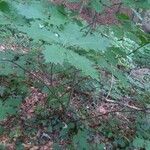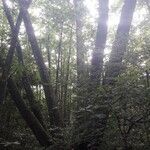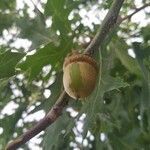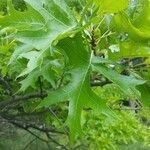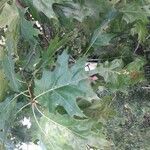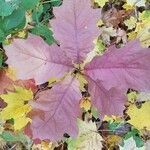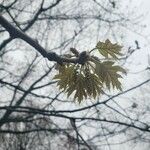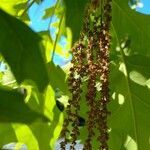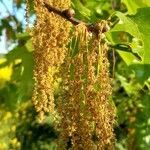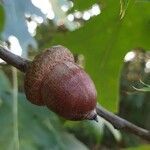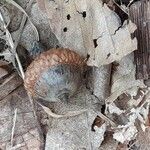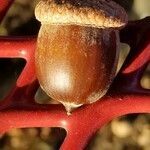Large deciduous tree (to c. 25 m tall in cultivation); bark rough and fissured. Shoots dark reddish brown or brown, glabrous, with prominent lenticels. Buds glabrous, without surrounding stipules; apex sometimes hairy. Petiole to 6 cm long. Stipules soon caducous. Lamina on adult shoots mostly 11-20 × 7-15 cm, ovate or ovate-oblong, with 3-5 pairs of lobes extending ⅓-⅔ distance from apex to midrib, slightly shining above, turning deep red before falling, usually glabrous, subcoriaceous, sometimes with a few brownish hairs in vein axils beneath; lobes with aristate apex, usually with 1-4 aristate teeth, sometimes entire; base cuneate. ♂ catkins to c. 8 cm long; lower fls distant; rachis with curly hairs; perianth 1.7-2.3 mm long, with curly hairs on margin; stamens 3-5. Fruiting peduncles 1-1.5 cm long, with 1-(2) fertile frs; frs reaching maturity in second year. Cup 1.5-2 cm diam., shallow; scales ovate, appressed, glabrous or minutely puberulent. Acorn 2-2.5 cm long, ovoid, c. 1/4 enclosed by cup.
Tree to 50 m; bark smoothish and with a reddish-purple cast until the trunk is 2–3 dm thick, eventually developing broad, shallow furrows between the narrow, flat, gray ridges; inner bark reddish or red-brown; young twigs glabrous, dark reddish-brown; lvs dull green, 10–20 cm, soon glabrous throughout or often with small tufts of persistent hairs on the vein-axils beneath, 7–11-lobed, the lobes roughly triangular, broadest at base, bristle-tipped and usually with a few lateral teeth, little if at all longer than the width of the central body of the blade; crown-lvs often more deeply cleft than the lower lvs as just described; acorn to 3 cm, its cup shallow, saucer-shaped, 2–3 cm wide and covering a fifth or a fourth of the nut, or sometimes the cup somewhat narrower and deeper and enclosing a third of the somewhat smaller (2–2.5 cm) nut; acorn-cup with a ring of hairs inside around the scar. N.S. and P.E.I. to Ga., w. to Minn. and Okla. (Q. borealis)
A medium sized tree. It grows to 25 m tall and spreads to 22 m wide. The trunk is 30-90 cm wide. It has long dark green leaves with pointed lobes. The leaves are 10-20 cm long. There are 7-9 lobes. The base is broadly wedge shaped. The are several large bristle tipped teeth. Each lobe tapers towards the tip. The leaf stalk is 2.5-5 cm long. These turn reddish and yellow-brown in autumn. The fruit are acorns. These are 12-25 mm long and almost as wide. The cup is saucer shaped. It encloses one quarter of the nut.
